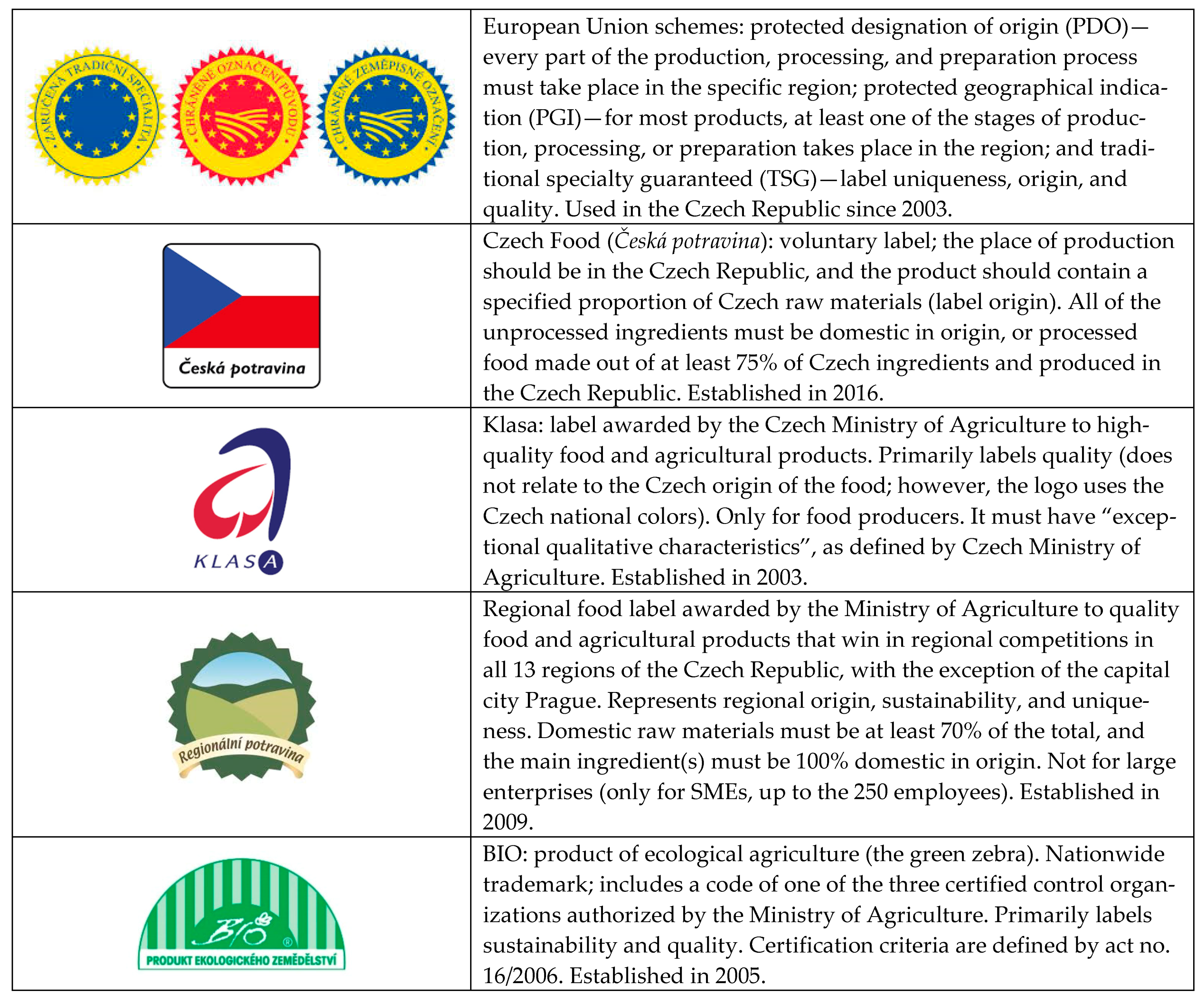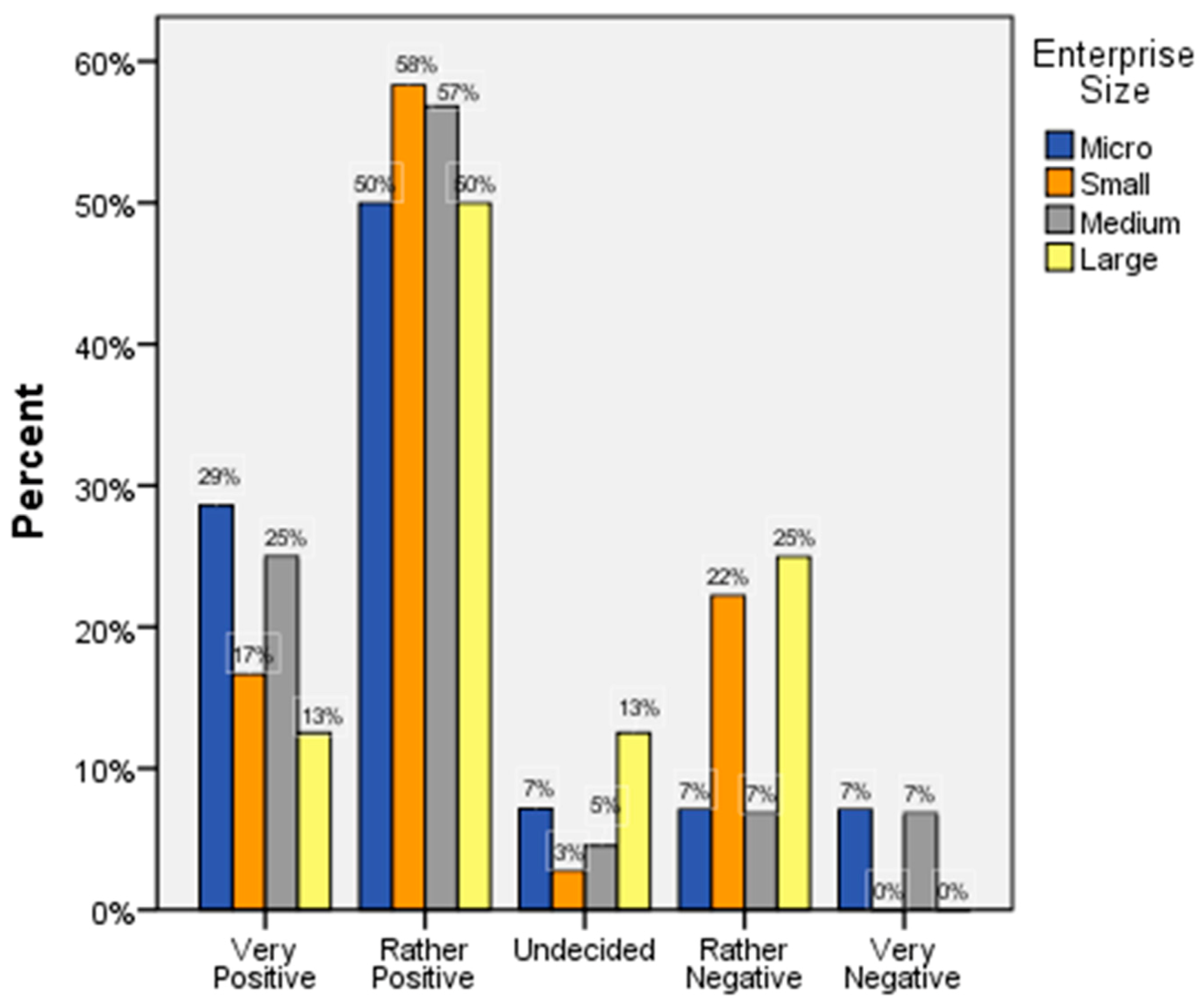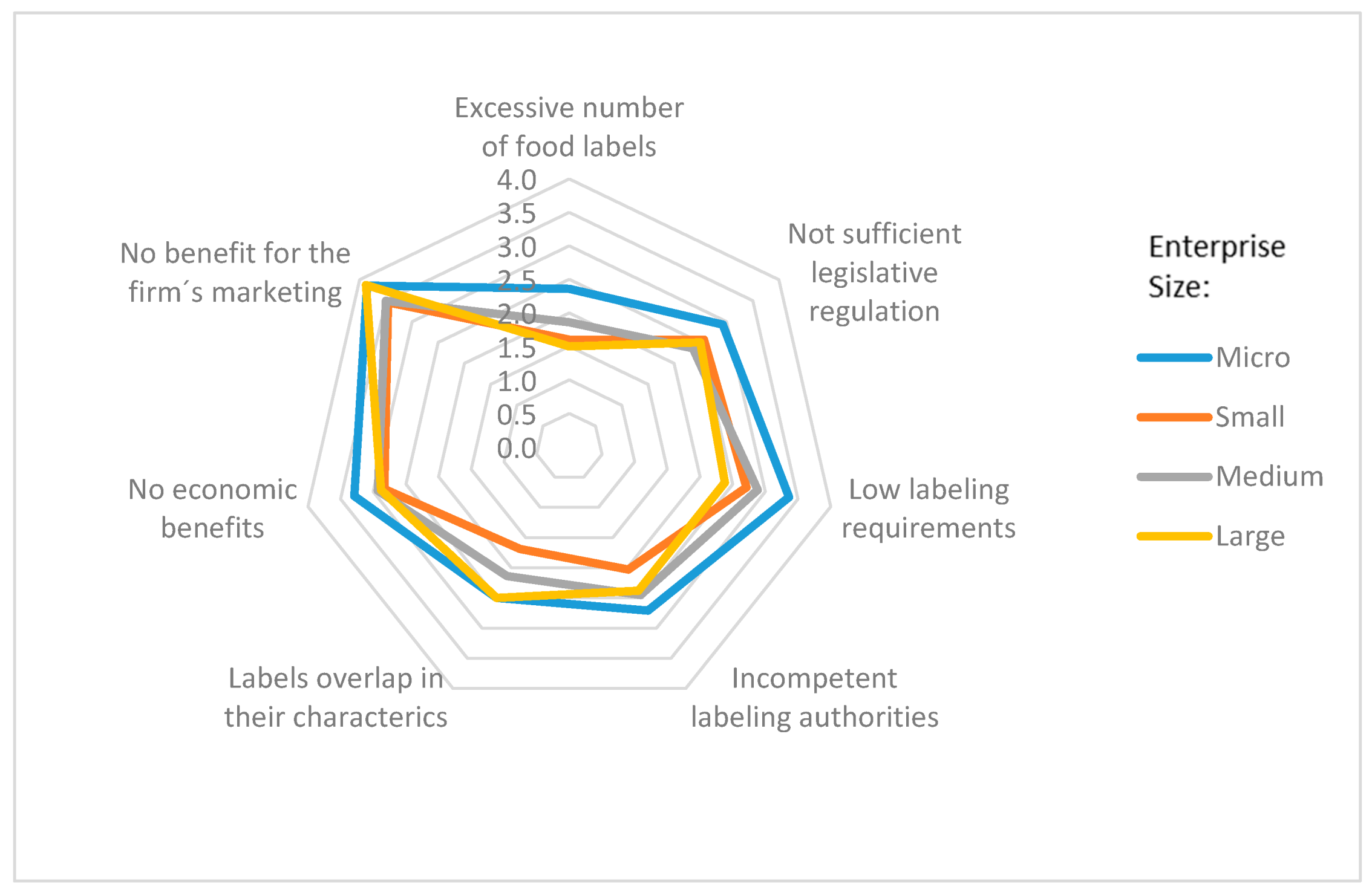Food Labels (Quality, Origin, and Sustainability): The Experience of Czech Producers
Abstract
1. Introduction
Major Food Labeling Systems in the Czech Republic, with Focus on Origin, Quality, and Sustainability
2. Materials and Methods
3. Results
4. Discussion
5. Conclusions
Supplementary Materials
Author Contributions
Funding
Institutional Review Board Statement
Informed Consent Statement
Data Availability Statement
Acknowledgments
Conflicts of Interest
References
- Albuquerque, T.G.; Oliveira, M.B.P.; Costa, H.S. 25 years of European Union (EU) quality schemes for agricultural products and foodstuffs across EU Member States. J. Sci. Food Agric. 2018, 98, 2475–2489. [Google Scholar] [CrossRef]
- Tonkin, E.; Meyer, S.B.; Coveney, J.; Webb, T.; Wilson, A.M. The process of making trust related judgements through interaction with food labelling. Food Policy 2016, 63, 1–11. [Google Scholar] [CrossRef]
- Weinrich, R.; Spiller, A. Developing food labelling strategies: Multi-level labelling. J. Clean. Prod. 2016, 137, 1138–1148. [Google Scholar] [CrossRef]
- Sadílek, T. Consumer preferences regarding food quality labels: The case of Czechia. Br. Food J. 2019, 121, 2508–2523. [Google Scholar] [CrossRef]
- Bernard, J.C.; Duke, J.M.; Albrecht, S.E. Do labels that convey minimal, redundant, or no information affect consumer perceptions and willingness to pay? Food Qual. Prefer. 2019, 71, 149–157. [Google Scholar] [CrossRef]
- Ramos, F.D.; Squeff, T.C. The Importance of Labelling Food Items: Information, Food Security and Sustainable Consumption. In Sustainable Consumption; Springer International Publishing: Berlin/Heidelberg, Germany, 2020; pp. 229–247. [Google Scholar]
- Kos Skubic, M.; Erjavec, K.; Klopčič, M. Consumer awareness of PDO-labelled food in Slovenia. Ital. J. Anim. Sci. 2019, 18, 366–371. [Google Scholar] [CrossRef]
- Van Ittersum, K.; Meulenberg, M.T.G.; van Trijp, H.C.M.; Candel, M.J.J.M. Consumers’ Appreciation of Regional Certification Labels: A Pan-European Study. J. Agric. Econ. 2007, 58, 1–23. [Google Scholar] [CrossRef]
- Forney, J.; Häberli, I. Introducing ‘Seeds of Change’ into the Food System? Localisation Strategies in the Swiss Dairy Industry. Sociol. Ruralis 2016, 56, 135–156. [Google Scholar] [CrossRef]
- Fraser, I.; Balcombe, K. Wrapped in the Flag: Food Choice and Country of Origin Labelling. EuroChoices 2018, 17, 37–42. [Google Scholar] [CrossRef]
- Brown, K.A.; Harris, F.; Potter, C.; Knai, C. The future of environmental sustainability labelling on food products. Lancet Planet. Health 2020, 4, e137–e138. [Google Scholar] [CrossRef]
- Miranda-Ackerman, M.A.; Azzaro-Pantel, C. Extending the scope of eco-labelling in the food industry to drive change beyond sustainable agriculture practices. J. Environ. Manag. 2017, 204, 814–824. [Google Scholar] [CrossRef]
- Schwartz, D.; Loewenstein, G.; Agüero-Gaete, L. Encouraging pro-environmental behaviour through green identity labelling. Nat. Sustain. 2020, 3, 746–752. [Google Scholar] [CrossRef]
- Bryła, P. The role of appeals to tradition in origin food marketing. A survey among Polish consumers. Appetite 2015, 91, 302–310. [Google Scholar] [CrossRef]
- Verbeke, W. Food quality policies and consumer interests in the EU. In Consumer Attitudes to Food Quality Products; Emphasis on Southern Europe; Wagenigen Academic Publishers: Cambridge, MA, USA, 2013. [Google Scholar]
- Grunert, K.G.; Aachmann, K. Consumer reactions to the use of EU quality labels on food products: A review of the literature. Food Control 2016, 59, 178–187. [Google Scholar] [CrossRef]
- Mol, A.P.J.; Lauber, V. The Voluntary Approach to Environmental Policy: Joint Environmental Policy-Making in Europe; Oxford University Press: New York, NY, USA, 2000. [Google Scholar]
- Bingen, J. Labels of origin for food, the new economy and opportunities for rural development in the US. Agric. Human Values 2012, 29, 543–552. [Google Scholar] [CrossRef]
- Doherty, E.; Campbell, D. Demand for safety and regional certification of food. Br. Food J. 2014, 116, 676–689. [Google Scholar] [CrossRef]
- Fonte, M. The construction of origin certification. Knowledge and local food. In Naming Food after Places, Food Relocalization and Knowledge Dynamics in Rural Development; Ashgate: Farnham, UK, 2010; pp. 149–171. ISBN 978-0-7546-7718-5. [Google Scholar]
- Gracia, A.; De-Magistris, T. Consumer preferences for food labeling: What ranks first? Food Control 2016, 61, 39–46. [Google Scholar] [CrossRef]
- Eldesouky, A.; Mesias, F.J.; Escribano, M. Perception of Spanish consumers towards environmentally friendly labelling in food. Int. J. Consum. Stud. 2020, 44, 64–76. [Google Scholar] [CrossRef]
- Brons, A.; Oosterveer, P. Making Sense of Sustainability: A Practice Theories Approach to Buying Food. Sustainability 2017, 9, 467. [Google Scholar] [CrossRef]
- Gracia, A.; De Magistris, T. The demand for organic foods in the South of Italy: A discrete choice model. Food Policy 2008, 33, 387–397. [Google Scholar] [CrossRef]
- Fotopoulos, C.; Krystallis, A. Purchasing motives and profile of the Green organic consumer: A countrywide survey. Br. Food J. 2002, 104, 730–765. [Google Scholar] [CrossRef]
- Davies, A.; Titterington, A.J.; Cochrane, C. Who buys organic food? A profile of the purchasers of organic food in Northern Ireland. Br. Food J. 1995, 97, 17–23. [Google Scholar] [CrossRef]
- Hashem, S.; Migliore, G.; Schifani, G.; Schimmenti, E.; Padel, S. Motives for buying local, organic food through English box schemes. Br. Food J. 2018, 120, 1600–1614. [Google Scholar] [CrossRef]
- Nicolosi, A.; Laganà, V.R.; Laven, D.; Marcianò, C.; Skoglund, W. Consumer Habits of Local Food: Perspectives from Northern Sweden. Sustainability 2019, 11, 6715. [Google Scholar] [CrossRef]
- Onozaka, Y.; McFadden, D.T. Does Local Labeling Complement or Compete with Other Sustainable Labels? A Conjoint Analysis of Direct and Joint Values for Fresh Produce Claim. Am. J. Agric. Econ. 2011, 93, 693–706. [Google Scholar] [CrossRef]
- Chalupová, M.; Prokop, M.; Rojík, S. Regional Food Preference and Awareness of Regional Labels in Vysočina Region (Czech Republic). Eur. Countrys. 2016, 8, 109–122. [Google Scholar] [CrossRef]
- Ratinger, T.; Bošková, H. Do Consumers and Producers Benefit from Labels of Regional Origin? The Case of the Czech Republic. In Consumer Perception of Food Attributes; CRC Press: Boca Raton, FL, USA, 2018; p. 306. ISBN 9781315296210. [Google Scholar]
- Stoklasa, M.; Starzyczna, H. Regional brand benefits for companies—Comparison of 2013 and 2015/6. In Proceedings of the XIX, Mezinárodní Kolokvium o Regionálních Vědách, Sborník Příspěvků, Brno, Czech Republic, 20 June 2016; Masaryk University: Brno, Czech Republic, 2016; pp. 210–217. [Google Scholar]
- Velčovská, Š.; Hadro, D. Generation Y Perceptions and Expectations of Food Quality Labels in the Czech Republic and Poland. Acta Univ. Agric. Silvic. Mendelianae Brun. 2018, 66, 325–334. [Google Scholar] [CrossRef]
- Chalupová, M.; Rojík, S.; Pilař, L.; Prokop, M. Factors Affecting Food Purchases in Vysočina Region with Focus on Regional Food. Agris On-line Pap. Econ. Inform. 2019, 11, 35–44. [Google Scholar] [CrossRef]
- Haenraets, U.; Ingwald, J.; Haselhoff, V. Gütezeichen und ihre Wirkungs-beziehungen—Ein Literaturüberblick. Der Markt 2012, 51, 147–163. [Google Scholar] [CrossRef]
- Czech Ministry of Agriculture Regionální potraviny (Regional Food). Available online: http://eagri.cz/public/web/regionalni_potraviny (accessed on 5 May 2020).
- Ščasný, M.; Urban, J.; Zvěřinová, I. Environmentally Significant Behaviour in the Czech Republic: Energy, Food and Transportation; Karolinum: Prague, Czech Republic, 2013; ISBN 978-80-246-2076-3. [Google Scholar]
- Velčovská, Š.; Del Chiappa, G. The Food Quality Labels: Awareness and Willingness to Pay in the Context of the Czech Republic. Acta Univ. Agric. Silvic. Mendelianae Brun. 2015, 63, 647–658. [Google Scholar] [CrossRef]
- Hes, A.; Skorepa, L.; Dusek, J. Individual aspects of behaviour consumer in the Czech Republic. In Acta Universitatis Bohemiae Meridionales; University of South Bohemia: Ceske Budejovice, Czech Republic, 2006; Volume 9, pp. 57–64. [Google Scholar]
- Horská, E.; Ürgeová, J.; Prokeinová, R. Consumers’ food choice and quality perception: Comparative analysis of selected Central European countries. Agric. Econ. Czech 2011, 57, 493–499. [Google Scholar] [CrossRef]
- Margarisová, K.; Vokáčová, L.; Kuralová, K.; Hlavsa, T. Regional Branding: Customer’s Experience with the Certified Products. Acta Univ. Agric. Silvic. Mendelianae Brun. 2018, 66, 1549–1556. [Google Scholar] [CrossRef]
- Ministry of Agriculture of the Czech Republic. Pravidla pro Dobrovolné Označování “Česká Potravina” a Použití Loga [In Czech, Rules for Voluntary Labelling “Czech Food” and Use of the Logo]; Ministry of Agriculture of the Czech Republic: Prague, Czech Republic, 2016; p. 53.
- Čadilová, K. Regionální Značení v České Republice a Na Slovensku; Asociace regionálních značek (ARB): Prague, Czech Republic, 2011; ISBN 978-80-254-9506-3. [Google Scholar]
- Rojík, S.; Pilař, L.; Kauerová, L.; Chalupová, M.; Prokop, M. Regional Product Labelling System Znojemsko Regionální Produkt From The Point Of Consumer Behaviour´s View. Mark. Identity 2016, 12, 403–414. [Google Scholar]
- Bošková, I.; Ratinger, T.; Kličková, K. The food industry structure under the effect of increasing number of regional products and small processing entities in the Czech Republic. In Proceedings of the 149th EAAE Seminar ‘Structural Change in Agri-Food Chains: New Relations between Farm Sector, Food Industry and Retail Sector, Rennes, France, 27–28 October 2016. [Google Scholar]
- Pilař, L.; Balcarová, T.; Rojík, S.; Tichá, I.; Poláková, J. Customer experience with farmers’ markets: What hashtags can reveal. Int. Food Agribus. Manag. Rev. 2018, 21, 755–770. [Google Scholar] [CrossRef]
- Kareklas, I.; Carlson, J.R.; Muehling, D.D. “I Eat Organic for My Benefit and Yours”: Egoistic and Altruistic Considerations for Purchasing Organic Food and Their Implications for Advertising Strategists. J. Advert. 2014, 43, 18–32. [Google Scholar] [CrossRef]
- Yadav, R. Altruistic or egoistic: Which value promotes organic food consumption among young consumers? A study in the context of a developing nation. J. Retail. Consum. Serv. 2016, 33, 92–97. [Google Scholar] [CrossRef]
- Zámková, M.; Prokop, M. Comparison of Consumer Behavior of Slovaks and Czechs in the Market of Organic Products by Using Correspondence Analysis. Acta Univ. Agric. Silvic. Mendelianae Brun. 2014, 62, 783–795. [Google Scholar] [CrossRef]
- Drexler, D.; Fiala, J.; Havlíčková, A.; Potůčková, A.; Souček, M. The Effect of Organic Food Labels on Consumer Attention. J. Food Prod. Mark. 2018, 24, 441–455. [Google Scholar] [CrossRef]
- Stonehouse, J.M.; Forrester, G.J. Robustness of the t and U tests under combined assumption violations. J. Appl. Stat. 1998, 25, 63–74. [Google Scholar] [CrossRef]
- Rasch, D.; Guiard, V. The robustness of parametric statistical methods. Psychol. Sci. 2004, 46, 175–208. [Google Scholar]
- Gorgoňová, Š. Billions Spent on the Promotion of the Klasa Brand are Failing. Association of Private Farming Czech Republic. Available online: https://www.asz.cz/cs/pro-media/tiskove-zpravy/asz-cr-miliardy-vynalozene-na-propagaci-znacky-klasa-se-miji-ucinkem.html (accessed on 1 June 2020).
- Anholt, S. Places, Identity, Image and Reputation; Palgrave Macmillan: London, UK, 2010; ISBN 978-0-230-25128-1. [Google Scholar]
- Ilbery, B.; Morris, C.; Buller, H.; Maye, D.; Kneafsey, M. Product, Process and Place: An Examination of Food Marketing and Labelling Schemes in Europe and North America. Eur. Urban Reg. Stud. 2005, 12, 116–132. [Google Scholar] [CrossRef]
- Chauve, P.; Renckens, A. The European Food Sector: Are Large Retailers a Competition Problem? J. Eur. Compet. Law Pract. 2015, 6, 513–529. [Google Scholar] [CrossRef]
- Špička, J. Market Concentration and Profitability of the Grocery Retailers in Central Europe. Cent. Eur. Bus. Rev. 2016, 5, 5–24. [Google Scholar] [CrossRef]
- Hingley, M.; Boone, J.; Haley, S. Local Food Marketing as a Development Opportunity for Small UK Agri-Food Businesses. Int. J. Food Syst. Dyn. 2010, 1, 1–10. [Google Scholar] [CrossRef]
- Zagata, L. We want farmers’ markets! Case study of emerging civic food networks in the Czech Republic. Int. J. Sociol. Agric. Food 2016, 19, 347–364. [Google Scholar]
- Visser, J.; Trienekens, J.; Van Beek, P. Opportunities for Local for Local Food Production: A case in the Dutch Fruit and Vegetables. Food Syst. Dyn. 2013, 4, 73–87. [Google Scholar] [CrossRef]
- Dreyer, H.C.; Strandhagen, J.O.; Thomassen, M.K.; Romsdal, A.; Gran, E. Supply Chain Design and Control Principles in Local Food Production: A Norwegian Case Study. Proc. Food Sys. Dyn. 2014. [Google Scholar] [CrossRef]



| Territory in which the Respondent Enterprise Operates | |
| Czech Republic (the whole country) | 30.4% |
| Bohemia | 46.1% |
| Moravia | 18% |
| Silesia | 1.6% |
| Prague | 3.9% |
| Moravia and Silesia | 9.8% |
| Enterprise Categories | |
| Large enterprise | 7.8% |
| Medium enterprise | 43.2% |
| Small enterprise | 35.3% |
| Micro-enterprise | 13.7% |
| Product Category for which the Enterprise Received the Label | |
| Mill, bakery, and confectionery products | 21.6% |
| Meat and meat products | 20.6% |
| Milk and dairy products | 20.4% |
| Alcoholic beverages | 13.7% |
| Fruits and vegetables | 12.7% |
| Fish and fish products | 4.9% |
| Non-alcoholic beverages | 3.9% |
| Other | 2.2% |
| Pair Comparison: Expectation vs. Reality | Paired t-Test | Paired Wilcoxon Test | ||
|---|---|---|---|---|
| t | p-Value | Z | p-Value | |
| Increase in profits | −4.514 | 0.000 | −4.180 | 0.000 |
| Increase in sales volume | −8.032 | 0.000 | −6.115 | 0.000 |
| Greater promotion of a labeled product | −7.396 | 0.000 | −6.034 | 0.000 |
| Greater promotion of the entire business and product range | −5.213 | 0.000 | −4.800 | 0.000 |
| Better flow of information towards customers | −8.153 | 0.000 | −6.473 | 0.000 |
| Competitive advantage | −6.424 | 0.000 | −5.391 | 0.000 |
| Increase in distribution possibilities | −5.886 | 0.000 | −5.057 | 0.000 |
| Label as a link to a premium price | −2.525 | 0.007 | −2.567 | 0.005 |
| Increasing the prestige | −8.653 | 0.000 | −6.614 | 0.000 |
| Opportunity to participate in events organized by the labeling authorities | −0.501 | 0.309 | −0.597 | 0.275 |
| Median | Mean | |
|---|---|---|
| Tool to increase profits | 4 | 3.65 |
| Tool to increase sales volumes | 3 | 3.08 |
| Tool for greater promotion of a labeled product | 2 | 2.08 |
| Tool for a better flow of information towards customers | 2 | 2.00 |
| Competitive advantage | 2 | 2.82 |
| Tool to increase distribution possibilities | 4 | 3.44 |
| Label as a link to a premium price | 4 | 3.94 |
| Increasing the prestige | 2 | 2.29 |
| Opportunity to participate in events organized by the labeling authorities | 3 | 2.95 |
| Excessive Number of Food Labels | Insufficient Legislative Regulation | Low Labeling Requirements | Incompetent Labeling Authorities | Labels Overlap in Their Characteristics | No Economic Benefits | No Benefit for the Company’s Marketing | |
|---|---|---|---|---|---|---|---|
| Correlation Coefficient | −0.100 | −0.087 | −0.092 | 0.006 | −0.115 | 0.012 | −0.143 |
| p-value | 0.321 | 0.391 | 0.363 | 0.952 | 0.257 | 0.904 | 0.154 |
Publisher’s Note: MDPI stays neutral with regard to jurisdictional claims in published maps and institutional affiliations. |
© 2020 by the authors. Licensee MDPI, Basel, Switzerland. This article is an open access article distributed under the terms and conditions of the Creative Commons Attribution (CC BY) license (http://creativecommons.org/licenses/by/4.0/).
Share and Cite
Chalupová, M.; Rojík, S.; Kotoučková, H.; Kauerová, L. Food Labels (Quality, Origin, and Sustainability): The Experience of Czech Producers. Sustainability 2021, 13, 318. https://doi.org/10.3390/su13010318
Chalupová M, Rojík S, Kotoučková H, Kauerová L. Food Labels (Quality, Origin, and Sustainability): The Experience of Czech Producers. Sustainability. 2021; 13(1):318. https://doi.org/10.3390/su13010318
Chicago/Turabian StyleChalupová, Martina, Stanislav Rojík, Hana Kotoučková, and Lenka Kauerová. 2021. "Food Labels (Quality, Origin, and Sustainability): The Experience of Czech Producers" Sustainability 13, no. 1: 318. https://doi.org/10.3390/su13010318
APA StyleChalupová, M., Rojík, S., Kotoučková, H., & Kauerová, L. (2021). Food Labels (Quality, Origin, and Sustainability): The Experience of Czech Producers. Sustainability, 13(1), 318. https://doi.org/10.3390/su13010318





